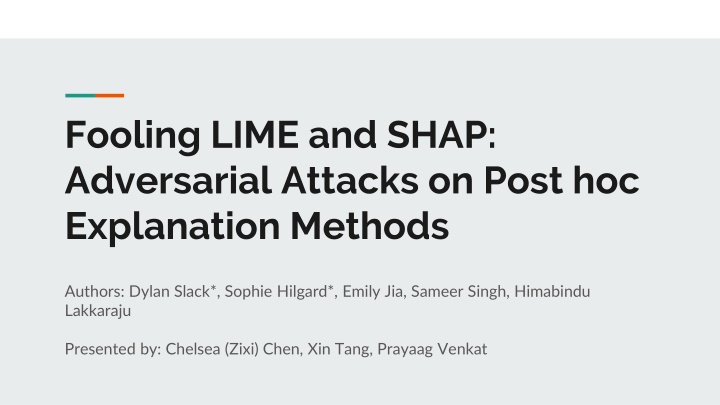Adversarial Attacks on Post-hoc Explanation Methods in Machine Learning
The study explores adversarial attacks on post-hoc explanation methods like LIME and SHAP in machine learning, highlighting the challenges in interpreting and trusting complex ML models. It introduces a framework to mask discriminatory biases in black box classifiers, demonstrating the limitations of current explanation techniques in sensitive applications.
Download Presentation

Please find below an Image/Link to download the presentation.
The content on the website is provided AS IS for your information and personal use only. It may not be sold, licensed, or shared on other websites without obtaining consent from the author.If you encounter any issues during the download, it is possible that the publisher has removed the file from their server.
You are allowed to download the files provided on this website for personal or commercial use, subject to the condition that they are used lawfully. All files are the property of their respective owners.
The content on the website is provided AS IS for your information and personal use only. It may not be sold, licensed, or shared on other websites without obtaining consent from the author.
E N D
Presentation Transcript
Fooling LIME and SHAP: Adversarial Attacks on Post hoc Explanation Methods Authors: Dylan Slack*, Sophie Hilgard*, Emily Jia, Sameer Singh, Himabindu Lakkaraju Presented by: Chelsea (Zixi) Chen, Xin Tang, Prayaag Venkat
Motivation ML has been applied for critical decision making Healthcare Criminal justice Finance The decision makers must clearly understand the model behavior to Diagnose the error and potential biases Decide when and how much these ML models should be trusted
Motivation Trade-off between interpretability and accuracy Simple models can be easily interpreted (e.g., linear regression) Complex but also black-box model has much better performance (e.g., deep neural network) Can a ML method be both interpertable and accurate? Post hoc explanation can seemingly solve this problem: First build complex and accurate ML models for good performance Then use post hoc explanation for model interpretation The question is: How robust and reliable is the post hoc explanation methods?
Contribution: A framework to fool the post hoc explanation method A novel framework that can effectively mask the discriminatory biases of any black box classifier Fooling the perturbation based post hoc explanation method LIME and SHAP Allowing an adversarial entity to control and generate an arbitrary desired explanation Demonstration using real-world datasets with extremely biased classifier Existing post hoc explanation techniques are NOT sufficiently robust for ascertaining discriminatory behavior of classifiers in sensitive applications
Preliminaries & Background f is the original classifier and x is the datapoint we want to explain g is the explanation we want to learn, ?(g) is the complexity of g ? is the proximity measure X is a synthetic dataset, consisting of perturbations of x
Approach: Set-up Adversary would like to deploy a biased classifier f! Background: the biased model f uses sensitive attributes to make critical decisions Requirement: give access of black-box models to customers and regulators who use post-hoc explanations Goal: hide bias of the classifier f
Approach: Set-up What do we need? Input: dataset sampled from real-world distribution Target Product: an adversarial classifier e f is the biased model to be explained, while is an unbiased model
Approach: OOD Detection Which of the inputs belong to the real-world distribution? Build another classifier for OOD detection Assign label False (not OOD) to all instance in the dataset X Perturb all instances in X and assign them label True (OOD) Exceptions: instances too close to observations from X Combine data and train OOD detection classifier
Experiment: Set-up 90% training & 10% test Biased classifier f makes predictions purely based on sensitive attributes (race, gender) Unbiased classifier uses only features uncorrelated with the sensitive attributes
Takeaway from experiments 1. Accuracy of the OOD classifier -> success of the adversarial attack 2. Adversarial classifiers to LIME are ineffective against SHAP explanations a. Any sufficiently accurate OOD classifier is sufficient to fool LIME, while fooling SHAP requires more accurate classifiers 3. SHAP less successful when using two features <- local accuracy property a. Distribute attributions among several features
Conclusions Main contribution: A framework for converting any black-box classifier into a scaffolded classifier that fools perturbation-based post-hoc explanation techniques like LIME and SHAP Effectiveness of this framework demonstrated on sensitive real-world data (criminal justice and credit scoring) Perturbation-based post-hoc explanation techniques are not sufficient to test whether classifiers discriminate based on sensitive attributes
Related Works Issues with post-hoc explanations: [Doshi-Velez and Kim] identify explainability of predictions as a potentially useful feature of interpretable models. [Lipton] and [Rudin] argues post-hoc explanations can be misleading and are not trustworthy for sensitive applications. [Ghorbani et al.] and [Mittelstadt et al.] identified further weaknesses of post-hoc explanations. Adversarial explanations [Dombrowski et al.] and [Heo et al.] show how to change saliency maps in arbitrary ways by imperceptibly changing inputs.
Q&A Are the experimental results sufficient to justify the conclusions? In particular, how can we explain the discrepancy in results for LIME vs. SHAP? What about fooling other classes of post-hoc explanation methods? Past work: gradient-based methods Alternatively, can one design post-hoc explanations that are adversarially robust?























